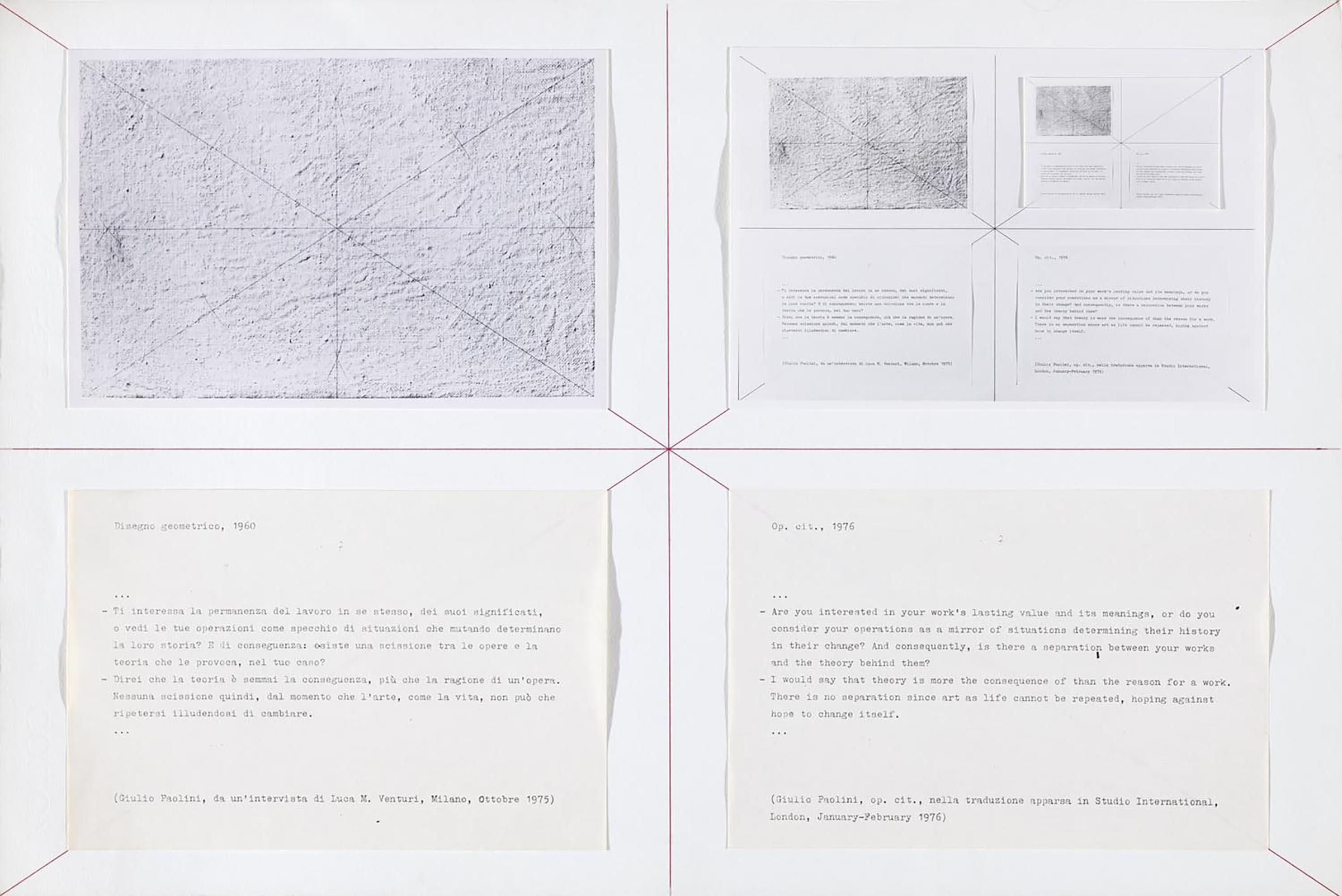Op. cit., 1976
GPE-0024
Photo prints, blueprints, collage and red ink drawing
40 x 60 cm
Signed, titled and dated on the verso, centre: “Giulio Paolini / Op. cit. / 1976”
Autograph numbering on the verso, centre
6 in Arabic numerals from 1/6 to 6/6
Self-produced by the artist
The size of the print (40 x 60 cm) and the squaring in red ink recall the format and the design that define Giulio Paolini's first painting, Disegno geometrico, 1960 (GPO-0001). The painting itself is reproduced in the photograph applied in the first of the four quadrants achieved by dividing the surface of the sheet by means of orthogonal axes. The second quadrant, in a clockwise direction, features a dual reproduction of the print itself, gradually reduced in size. In the third quadrant, a typewritten text, titled “Disegno geometrico, 1960”, offers an extract from the interview the artist gave to Luca Maria Venturi in October 1975. The passage includes a question asked by Venturi, followed by Paolini's answer: “LMV: Are you interested in your work’s lasting value and its meanings, or do you consider your operations as a mirror of situations determining their history in their change? And consequently, is there a separation between your works and the theory behind them? GP: I would say that theory is more the consequence rather than the reason for a work. There is no separation since art as life cannot be repeated, hoping against hope to change itself". In the fourth quadrant another typewritten sheet repeats the same text, but in an English translation with the title and the date of the print, “Op. cit., 1976”.1
According to an artist's statement made in 2000, the English translation of the original text would have been the reason to realize the work, born to rectify an error capable of compromising the key to interpretation of Disegno geometrico. “Due to an incorrect translation, the meaning of my discourse was inverted. It was a reference to my first painting inserted in a context that risked making it equivocal: an errata corrige”.2 The choice of the title – the abbreviation “op. cit.” borrowed from the bibliographical context indicates, in the notes to a text, a publication that was already cited in its entirety in a previous note – it wishes to refer to both the formulation of the original text and the ”work cited”, Disegno geometrico, and to its meaning.
In other words, Op. cit. intends to confirm the paradigmatic value of Disegno geometrico, recognizing and underscoring the universal value of its conceptual assumptions. In so far as it is a kind of universal set of guidelines for any representation, the painting from 1960 is a potentially unlimited container of images, which by definition inscribes every work that follows. As the typewritten text declares between the lines, Paolini's subsequent research, in fact, is none other than a repetition or a translation of that first work, however much it changes in shape.
1 Venturi's interview was published in English in Studio International 191, no. 979, London (January-February 1976), pp. 30-31.
2 The error can be found in the words “l’arte, come la vita, non può che ripetersi”, which in the English translation has become the opposite, “art as life cannot be repeated” (where “art as life” also risks being understood as “l’arte come vita” in Italian, a concept that is particularly not well liked by Paolini). Cf. G. Paolini in the interview with A. Madesani, "Conversazione fra Giulio Paolini e Angela Madesani", in Rubare l’immagine. Gli artisti e la fotografia negli anni ‘70, exhibition catalogue, Milan, Spazio Labs (Milan: Edizioni Tega, 2000), pp. 72-73.
Text: extract from “Giulio Paolini. An interview with Luca Venturi”, in Studio International 191, no. 979 (London), January-February, 1976, pp. 30-31.
| 1976 | Brescia, Banco (Galleria Massimo Minini), Giulio Paolini, 4-30 December. |
| 1992 | Bonn, Bonner Kunstverein, Giulio Paolini. Impressions graphiques. Das graphische Werk 1967-1992, 24 February - 29 March (catalogue Impressions graphiques. L’opera grafica 1967-1992 di Giulio Paolini [Turin: Marco Noire Editore, 1992], cat. no. 24). |
| 1993 | Winterthur, Kunstmuseum Winterthur, Giulio Paolini. Impressions graphiques. Das druckgraphische Werk 1967-1992, 16 January - 7 March (catalogue Impressions graphiques. L’opera grafica 1967-1992 di Giulio Paolini [Turin: Marco Noire Editore, 1992], cat. no. 24). |
| 1995 | Lisbon, Fundação Calouste Gulbenkian / Centro de Arte Moderna José de Azeredo Perdigão, Giulio Paolini. Impressions graphiques. Múltiplos e Obra Gráfica 1969-1995, 16 March - 28 May, not repr. in the exhibition brochure (catalogue Impressions graphiques. L’opera grafica 1967-1992 di Giulio Paolini [Turin: Marco Noire Editore, 1992], cat. no. 24). |
| 1996 | Apolda, Kunsthaus Apolda Avantgarde, Giulio Paolini. Impressions graphiques, 27 September - 27 October (catalogue Impressions graphiques. L’opera grafica 1967-1992 di Giulio Paolini [Turin: Marco Noire Editore, 1992], cat. no. 24). |
| 1997 | Göppingen, Kunsthalle, Giulio Paolini. Impressions graphiques. Das graphische Druckwerk 1967-1995, 9 March - 13 April (catalogue Impressions graphiques. L’opera grafica 1967-1992 di Giulio Paolini [Turin: Marco Noire Editore, 1992], cat. no. 24). |
| • | G. Paolini in the interview with A. Madesani, “Conversazione fra Giulio Paolini e Angela Madesani”, in Rubare l’immagine. Gli artisti e la fotografia negli anni ‘70, exhibition catalogue, Milan, Spazio Labs (Milan: edizioni Tega, 2000), pp. 72-73. |
| • | La città di Riga 1 (Pollenza: La nuova Foglio Editrice), Autumn, 1976, col. repr. pp. 64-65. |
| • | Impressions graphiques. L’opera grafica 1967-1992 di Giulio Paolini (Turin: Marco Noire Editore, 1992), cat. no. 24, col. repr. |



